Age of Discovery
period of European global exploration from early 15th century to 17th century
The Age of Discovery, also known as the Age of Exploration, was the period from the 15th century to the late 18th, when Europeans set sail to discover and explore other lands. It also marked the beginning of European colonialism and the start of the Mercantilist Age, as well as the beginning of globalization.
While the European explorers did discover many uninhabited islands, for the most part they were exploring lands that had been discovered and settled by other people thousands of years before. The widely-used term "Age of Discovery" reflects the Eurocentric view of the world that existed at the time.
For this article, we focus on seaborne exploration and consider the Age of Exploration to end with the navigators Cook, Vancouver, Tasman and Flinders exploring the Pacific in the late 18th century. This excludes various expansions over land — the Russian Empire, the Ottoman Empire, Imperial China, America's Old West and so on — and more recent explorations in the Arctic, Antarctica and Space.
The article In the footsteps of explorers takes a broader approach to exploration, including explorers from other time-periods and those not from Europe.
Understand
- See also: Early modern Europe, Maritime history
Though the great voyages of the Age of Discovery were neither the world's first nor the first major ones by Europeans, they were very influential. Trade routes had been maintained between the Roman Empire and the East via the Silk Road for many centuries.
The period from the 5th to the 15th century AD is in Europe known as the Middle Ages, earlier implied to be a "dark" age between the fall of the Roman Empire and the Renaissance and Age of Discovery. This view is today dismissed, and there were indeed many great explorers during the time, both Europeans and others. Vikings reached North America around 1000 CE. Marco Polo's book, published around 1300, told of the riches of the East and strongly influenced later exploration. The Islamic Golden Age produced explorers such as Ibn Battuta, who travelled further than any known person before him. China's Ming Dynasty sent the Ming Treasure Voyages across the South China Sea and Indian Ocean in the 15th century, making it as far the east coast of Africa.
The European Age of Discovery began in 1415, as the Portuguese captured the Moorish port of Ceuta in North Africa, marking the start of the Portuguese Empire. They were pioneers in the Age of Exploration, discovering the system of ocean currents and prevailing winds in the Atlantic Ocean, and striving to improve their shipbuilding and seamanship skills in order to use it. The understanding of the trade winds, and the development of triangular sails capable of crosswind sailing, enabled Europeans to sail across oceans and establish global empires.
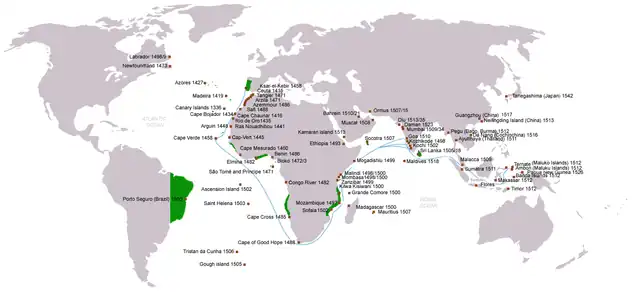
The Portuguese were the first Europeans to expand over the seas since the Vikings. First they discovered and settled some nearby and until then uninhabited archipelagos, Madeira in 1418 and the Azores in 1427.
Inaugurated around 1433, the Sagres nautical school, sponsored by Prince Henry the Navigator (1394-1460), was set up to study the maritime exploration of the Atlantic Ocean, which led to the reaching of Greenland, Newfoundland, Labrador, and the west coast of Africa. The discovery of a passable route around Cape Bojador by Portuguese mariner Gil Eanes in 1434 was a major breakthrough for European seamanship, of almost mystical significance. After Prince Henry's death, his pupils continued to voyage further and further, enabling Portugal to begin a major chapter in world history with the New World discoveries and a monopoly over trade between the Orient and Western Europe. The Portuguese explorer Bartolomeu Dias would become the first European to sight and sail around the Cape of Good Hope in 1488. Explorers Vasco da Gama and Pedro Álvares Cabral reached India in 1498 and Brazil in 1500, respectively, setting in motion the colonial scheme of occupation and exploitation.
Other countries soon joined in. Spain sent Columbus on a series of voyages starting in 1492, and also sent out voyages under other commanders; in 1519 they sent out the Magellan expedition, the first circumnavigation of the world. In the process, Magellan would become the first European to sail through "the Strait that shall forever bear his name", in 1520. This would be the main route for ships sailing between the Atlantic and Pacific oceans until the first European sighting and rounding of Cape Horn further south by the Dutch navigator Willem Schouten in 1616. John Cabot explored Newfoundland and nearby areas for the British starting in 1497. French exploratory voyages began around 1508 under Giovanni da Verrazzano, and what is now Quebec was claimed for the Kingdom of France by Jacques Cartier by 1540.
The Portuguese were the first Europeans to reach Indonesia, in 1512, with British, Dutch and Spanish traders not far behind. In medieval Europe, pepper cost more than its weight in gold, so the Spice Islands were an extremely valuable colony. Several small wars were fought over them, with the Dutch ending up in control.
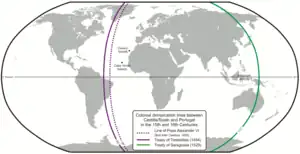
The Treaty of Tordesillas was signed in 1494 after the Pope mediated in a dispute between Portugal and Spain; it divided the non-Christian world between those two powers. The Protestant powers and even Catholic France ignored it.
- Spain was granted the right to occupy much of the New World, plus most of the Pacific. They soon grabbed most of the Americas, except Portuguese Brazil and various areas where the British, Dutch or French beat them to it.
- Portugal got Brazil and was granted a free hand in the Old World, except for Christian Europe. They rushed to establish bases (though generally not large colonies) all along the trade routes to the riches of the East. They held Angola, Goa, East Timor and Macau until the late 20th century. They were also in Sri Lanka, Malacca, the Spice Islands and Taiwan until the Dutch or the British displaced them.
The treaty allowed either nation to intrude into the other's zone provided the area was not yet colonized, they formed alliances with local rulers, and they spread the Faith. At least in the mind of the Spanish King, this justified taking the Philippines in the 1560s.
Past the Age of Discovery
It was the Portuguese, from their base in Macau, who first began serious trade with China and Japan. Later, other European powers and the U.S. joined in. However, both countries would maintain relatively isolationist trade policies until the 19th century, when the British forced China into very unfavorable trade terms following their victory in the First Opium War in 1842, and the Americans forced Japan to open up during the Black Ships incident in 1853.
Italy did not develop its own colonial empire until the late 19th century — they took Eritrea in 1882, Somalia in 1889, Libya in 1911, Ethiopia in 1936, and had a few small concessions in China — but many of the explorers in the early days were Italians. These included Columbus, Cabot, Verrazzano, Amerigo Vespucci and Magellan's chronicler, Antonio Pigafetta.
Along with military conquest and commerce, the other goal of imperialism was Christianizing the indigenous peoples, which was the role of missionaries. And except in Muslim, Hindu, Sikh and most Buddhist areas, and nations with their own longstanding Christian churches, they were very successful in attaining converts, eventually leading to Christianity becoming the world's most prolific religion, a position it maintains today. Many of the early missionaries to nations far from Europe took fascinating journeys which can be retraced, and there are many historical missions around the world with functioning churches and museums that can be visited.
The Europeans often maintained control over their colonies through a "divide and conquer" strategy, in which they would deliberately stoke tensions between different groups. Moreover, many people were shipped between far flung regions of the colonial empires to provide labour for the respective colonial masters. This has resulted in significant ethnic and religious tensions that have persisted even after the colonies gained independence, sometimes even resulting in civil wars, ethnic cleansings or genocides.
At the end of the 18th century and the beginning of the industrial era, the inland of many continents, as well as the polar regions, remained uncharted. Among famous inland expeditions were the Lewis and Clark expedition across North America, and the voyages of Sven Hedin across Central Asia. The North and South Pole were reached by humans only in the 20th century.
Eat and drink
The Age of Discovery also had a huge impact on global culinary culture, and many ingredients now seen as integral parts of many European cuisines such as potatoes, tomatoes and cocoa actually have their origins in the Americas. Turkeys are native to North America, and originally domesticated by the ancient Mesoamericans, but are today an integral part of the traditional English Christmas dinner. Similarly, chillis have become an integral part of many Asian and African cuisines despite their origin in what is today southern Mexico and Central America, having been brought to these areas by Spanish and Portuguese traders in the 16th century. Maize (corn), which is native to southern Mexico, has become a staple in many African cuisines. Sweet potatoes are originally from South America, but today China is the largest grower.
Unlike native American ingredients, native Australian ingredients have a comparatively minor impact on the global culinary scene, the sole exception being the macadamia nut, which is now one of Hawaii's major exports.
Crops and animals originally domesticated in the ancient Fertile Crescent — barley, wheat, cattle, sheep and others — spread to Europe in ancient times, and the Age of Discovery spread them to the rest of the world. Today agriculture in many temperate zone former colonies — including Canada, the U.S., Australia, New Zealand, South Africa and Argentina — is largely based on them.
Coffee had its origins in the Horn of Africa, but is now also grown in many other parts of the world, including parts of the Americas and Southeast Asia. Tobacco has also spread widely from its origins in the Americas.
Tea was introduced into Europe from China during the Age of Discovery, with Russia being the main player in the overland caravan routes via Siberia and Central Asia, while Portugal and the Netherlands initially dominated the sea routes though later the British took over much of the trade. The United Kingdom in particular took a liking to this new beverage, and tea drinking became a status symbol among the British nobility, thus giving rise to the traditional afternoon tea. The British also introduced commercial tea growing to their colonies in attempt to break the Chinese monopoly, and today, India, Sri Lanka, Kenya and Malaysia are major tea producers.
Explorers
This section lists many of the more famous explorers of the period.
Christopher Columbus
- Main article: Voyages of Columbus
Christopher Columbus (1451-1506) was a Genoese colonizer and explorer who made several voyages across in Atlantic in the service of the Spanish crown from 1492-1502, thus kickstarting the Age of Discovery and the formation of the Spanish colonial empire. While he never set foot in what are now the states of the United States of America, his voyages are celebrated in the form of the public holiday Columbus Day.
John Cabot
John Cabot, or Giovanni Caboto, (c. 1450 – c. 1500) was a Venetian working for the English King who made three trips west from Bristol in 1497 and 1498. The records are scanty and their interpretation controversial, but it seems that he was the first European since the Vikings to reach Newfoundland.
One of his sons, Sebastian, was also an explorer; working for the English King between 1504 and 1512 he explored the North American coast as far south as Chesapeake Bay and became the first to look for the Northwest Passage, following the north coast of what is now Quebec until the weather forced him to turn back. Later he worked for Spain exploring South America.
Vasco da Gama
- Main article: Cape Route
Vasco da Gama (c.1460-1524) was a Portuguese explorer who became the first European to reach India by sea, going around Africa in the process. His voyages thus allowed Portugal to establish a colonial empire in much of Africa and Asia.
Ferdinand Magellan
- Main article: Magellan-Elcano circumnavigation
Ferdinand Magellan (c.1480-1521) was a Portuguese explorer in the service of the Spanish crown who organised the first circumnavigation of the globe, and became the first European to reach Asia from the east, by first sailing through the strait that was later named after him. Magellan himself was killed in a tribal war in Mactan in what is now the Philippines, and the circumnavigation was completed by his subordinate commander Juan Sebastián Elcano.
Hernán Cortés
Hernán Cortés (1485-1547) is best known as the Spanish conquistador who conquered the Aztec empire, paving the way for the rise of the Spanish Empire in the Americas. The conquistadors were the earliest Spanish explorers in the Americas, but they were motivated mostly by greed and glory, seeking dominion over the indigenous peoples and appropriation of their gold and silver (which they found in abundance in Mesoamerica). Cortés conquered a large area stretching from Veracruz on the Gulf of Mexico across Central Mexico to the Pacific coast.
Jacques Cartier
Jacques Cartier (1491-1557) was a Breton who explored the Gulf of Saint Lawrence (which he named, because he arrived there on the Saint's feast day) and the Saint Lawrence River for France between 1531 and 1542. He was the first European to reach what were then indigenous settlements and are now Quebec City and Montreal. He could not go beyond Montreal due to rapids.
He did not command the third voyage in 1541-42. This was to be France's first attempt at establishing a permanent settlement in the New World, and overall command was given to de Roberval who was to be governor of the colony; Cartier was chief navigator. The colony failed, but by then Cartier was already retired in St Malo which now has a Jacques Cartier Museum.
Juan Rodriguez Cabrillo
In 1542, Juan Rodriguez Cabrillo (c.1497-1543) was a Spanish explorer who sailed north from Mexico to explore the North American west coast. He is recognized as the first European to set foot in what is now the U.S. state of California and his crew sailed as far north as the Rogue River in Oregon before winter weather caused the ship to turn south to return to Mexico. The place where Cabrillo first landed in San Diego is the site of a U.S. National Monument. Cabrillo would never finish his exploration of the west coast, he died in the Channel Islands in 1543 after shattering his leg in a fall.
St. Francis Xavier
St. Francis Xavier (1506-1552) was a Navarrese Catholic missionary who was one of the founders of the Society of Jesus (Jesuits). He led evangelization efforts in much of the Portuguese colonial empire in Asia, in particular Goa and Malacca, and became the first Christian missionary to reach Borneo, the Maluku Islands and Japan. He was on a diplomatic mission to China when he fell ill and died on the island of Shangchuan near Taishan, Guangdong. Initially buried on a beach on the island, his body was later exhumed and moved to St Paul's Church in Malacca (now in ruins). He would later be moved again to the Basilica of Bom Jesus in Goa, where he lies to this day.
- 🌍 St. Francis Church, Shangchuan Island, Taishan, China. Church built in memory of St. Francis Xavier on the spot where he died. (updated Jul 2023)
- 🌍 Basilica of Bom Jesus, Goa, India. St. Francis Xavier's final resting place. (updated Jul 2023)
- 🌍 Ruins of Saint Paul's Church, Malacca, Malaysia. Ruins of a church built by the Portuguese. It was here that St. Francis Xavier stayed during his sojourn in Malacca, and founded the first modern school in the Malay Peninsula knowns as St Paul's College. Following his death in China, St Francis Xavier's body was temporarily interred here before eventually being transferred to his final resting place in Goa, India. (updated Jul 2023)
- 🌍 St. Francis Xavier Memorial Church (平戸ザビエル記念教会), Hirado, Nagasaki Prefecture, Japan. Church built in 1913 to commemorate the visit of St. Francis Xavier to Hirado in 1550, with a statue of him in front of the church. (updated Jul 2023)
- 🌍 Xavier Park (ザビエル公園), Kagoshima, Japan. Park commemorating the stay of St. Francis Xavier in Kagoshima, with statues of him and his two Japanese disciples Anjiro and Bernardo, the former of whom was the first record Japanese Christian, and that latter of whom was the first Japanese to set foot on European soil. The park is also home to the ruins of the Xavier Church that was built in his honour in 1908, but destroyed in a World War II bombing raid. (updated Jul 2023)
- 🌍 Monument of St. Xavier’s Landing (ザビエル上陸記念碑), Kagoshima, Japan. Located in Gionnosu Park, on the site where St. Francis Xavier first landed in Japan. (updated Jul 2023)
Sir Francis Drake
Sir Francis Drake (1540-1596) was an English explorer and privateer, famous for sailing around the world, including leading the first circumnavigation of the globe under a single commander from 1577 to 1580, and for his many raids on Spanish waters. The most notable of these were his attack on Cartagena de Indias in April 1586 with 23 ships and 3,000 men, burning 200 houses and the cathedral, and departing only after a ransom was paid a month later; and the "singeing of King Philip's beard" in 1587, against Cádiz, A Coruña and the Spanish Armada, occupying the harbours and destroying 37 naval and merchant ships. Legend says, on his return, he raided and destroyed the old Sagres school, a Spanish asset at this time; when Golden Hinde arrived and docked at the Tower of London, Queen Elizabeth I went aboard with the French ambassador, announced him "Sir", and handed the Frenchman a sword to perform the deed (and embroil the French and Spanish empires against each other). His legacy is mixed; in Latin America, El Draque is remembered mostly as a pirate, whereas the Anglosphere sees him as a bona fide explorer.
Matteo Ricci
Matteo Ricci (1552-1610) was an Italian Jesuit priest who led Roman Catholic evangelization efforts in China. Born in Macerata, then part of the Papal States, he joined the Society of Jesus while studying in Rome at the Roman College in 1571. He set off from Lisbon on a missionary expedition to Asia in 1578 and arrived in the then-Portuguese colony of Goa later that year. He was then dispatched from Goa to Macau, then a Portuguese trading post, in 1582, where studied Chinese language and culture, becoming one of the first Westerners to master the Chinese writing system and literary classics. From Macau he would later travel into the Chinese heartland, eventually reaching the capital Beijing in 1598. While in Beijing, Ricci became an advisor to the imperial court of the Ming Dynasty, becoming the first Westerner to be invited into the Forbidden City. Ricci introduced Western knowledge to China, including by publishing the first world map in the Chinese language in 1602. He also managed to convert several important Chinese officials to Christianity by, rather controversially, devising a new set of liturgical rites for China that incorporated elements of Confucianism such as the veneration of ancestors. When Ricci died in 1610, although Chinese law at that time required foreigners who died in China to be buried in Macau, the emperor granted special dispensation for him to be buried in Beijing due to his contributions to China.
- 🌍 Statue of Matteo Ricci, Macau. Unveiled in 2010 on the anniversary of Matteo Ricci's arrival in the city, the statue sits on the site where the College of St. Paul, where Ricci had stayed while in Macau, once stood. (updated Jul 2023)
- 🌍 Cathedral of the Immaculate Conception (圣母无染原罪堂), Beijing, China. Church founded by Matteo Ricci, and the oldest Roman Catholic church in Beijing. (updated Jul 2023)
- 🌍 Zhalan Cemetery (滕公栅栏), Beijing, China. Cemetery where Matteo Ricci and numerous Jesuits who came after him were buried. (updated Jul 2023)
- 🌍 Former site of Temple of Flowers of the Saints (利玛窦仙花寺遗址), Zhaoqing, China. The former site of the Temple of Flowers of the Saints, the first Roman Catholic church in the Chinese mainland, which was founded by Matteo Ricci. A plaque commemorating the former existence of the church now stands on the site. (updated Jul 2023)
- 🌍 Library of Congress, Washington, D.C., United States. Houses Matteo Ricci's Kunyu Wanguo Quantu (坤輿萬國全圖), the first map of the world to be published in the Chinese language. (updated Jul 2023)
Henry Hudson
Henry Hudson (1565-1611?) was an Englishman who led several expeditions to the New World. Most were under the English flag, searching for the Northwest passage, though on one he explored areas further south for the Dutch East India Company, leading to that company founding "New Amsterdam" which later became New York City. The Hudson River, Hudson's Bay and various other things were named for him.
Samuel de Champlain
Samuel de Champlain (1567–1635) was a French colonist, navigator, cartographer, draftsman, soldier, explorer, geographer, ethnologist, diplomat, and chronicler. He made over twenty trips across the Atlantic Ocean, and founded Quebec City and New France in 1608. An important figure in Canadian history, Champlain created the first accurate coastal map during his explorations, and founded various colonial settlements.
Abel Tasman
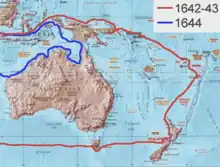
In November 1642, Dutch East India Company commander Abel Tasman (1603-1659), exploring from Mauritius under orders of Anthony van Diemen, governor-general of the Dutch East Indies, found Tasmania island, and claimed it. He named it "Van Diemen's Land" after his patron; it was re-named to its current name after him in 1856. A cape and a group of islands in northern New Zealand are still called by names given by Tasman, and Abel Tasman National Park on the South Island is named for him. He reportedly reached Fiji and Tonga, later returning to Batavia.
His second voyage took place in 1644; he mapped a part of Australia's northern coast, but failed to find the Torres Strait and a possible trade route, and the expedition was deemed a failure.
Vitus Bering
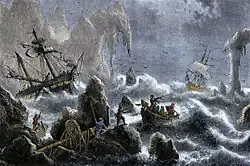
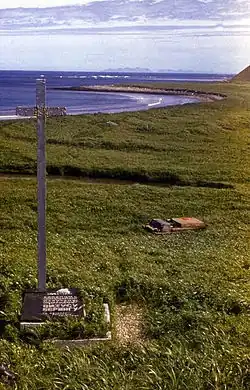
Danish cartographer and explorer Vitus Jonassen Bering (1681-1741), also known as Ivan Ivanovich Bering, an officer in the Russian Navy, explored the Bering Sea region and claimed Kamchatka (1725-28) and Alaska (1741) on behalf of the Russian Empire. The Bering Strait, the Bering Sea, Bering Island (where he is buried, after dying while underway), the Bering Glacier and the Bering Land Bridge were all named in his honor. He was neither the first Russian to sight North America (that having been achieved by Mikhail Gvozdev during the 1730s), nor the first Russian to pass through the strait which now bears his name (an honour which goes to the relatively unknown 17th-century expedition of Semyon Dezhnev). Reports from his second voyage were jealously guarded by the Russian administration, preventing Bering's story from being retold in full for at least a century after his death. Nonetheless, Bering's achievements, both as an individual explorer and as a leader of the second expedition, have never been doubted. Captain James Cook, despite knowledge of Dezhnev's earlier expedition, chose to use the name "Bering Strait".
James Cook
- Main article: Voyages of James Cook
Born in 1728, Cook joined the Royal Navy in 1755, eventually rising to the rank of captain. He saw action in the Seven Years' War and subsequently surveyed and mapped much of the entrance to the Saint Lawrence River during the siege of Quebec, which brought him to the attention of the Admiralty and Royal Society. This led to his commission in 1766 as commander of HM Bark Endeavour for the first of three expeditions around the Pacific Ocean, during which he achieved the first recorded circumnavigation of New Zealand, as well as the first European contact and waypoint naming on the eastern coastline of Australia. He was killed at Kealakekua Bay in Hawaii on 14 February 1779, in a conflict with locals.
Louis Antoine de Bougainville
Louis-Antoine, Comte de Bougainville (1729–1811) from Saint-Malo was a French admiral and explorer. A contemporary of James Cook, he took part in the Seven Years' War in North America and the American Revolutionary War against Britain. Bougainville later gained fame for his expeditions, including a scientific circumnavigation of the globe in 1763, the first recorded settlement on the Falkland Islands which he named "Isles Malouines", and voyages into the Pacific Ocean. Bougainville Island of Papua New Guinea, as well as the Bougainvillea genus of tropical ornamental plants, were named after him.
George Vancouver
- Main article: Voyages of George Vancouver
Vancouver was a British officer of the Royal Navy best known for his 1791–95 expedition, to lay formal British claim and start colonization of North America's northwestern Pacific Coast regions previously mapped by James Cook. The Canadian city of Vancouver, as well as the nearby Vancouver Island were named after him. The colony was called British Columbia, and became a province of Canada in 1871.
Matthew Flinders
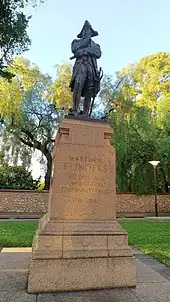
- Main article: Voyages of Matthew Flinders
Captain Matthew Flinders (1774–1814) was an English navigator, cartographer and officer of the Royal Navy who led the second circumnavigation of New Holland, that he would subsequently call "Australia", and identified it as a continent. Flinders made three voyages to the Southern Ocean between 1791 and 1810.
Today, Flinders is often forgotten about in his home country (England), but he is well known to Australians, and many places in Australia are named after him.
See
Wikivoyage has itinerary articles for some of the greatest voyages of the Age of Discovery:
- Voyages of Columbus — Spain to the Caribbean, 1492
- Cape Route — Vasco da Gama, Portugal to India by going south around Africa, 1498
- Magellan-Elcano circumnavigation — around the world, by going past the southern tip of mainland South America, 1519-1521
- Voyages of James Cook — United Kingdom to the Pacific, 1766-1780
- Voyages of George Vancouver — United Kingdom to the west coast of North America, 1791–1795
- Voyages of Matthew Flinders — United Kingdom to Australia, 1791-1810
Europe
In Lisbon, the capital of Portugal, see the Torre de Belém where Portuguese explorers embarked on their voyages to distant lands, and where they disembarked on their return to the motherland. The Museu da Marinha (Maritime Museum) in the Belém district, evokes Portugal's domination of the seas. Its collections include model ships from the Age of Discovery onward. The oldest exhibit is a wooden figure representing the Archangel Raphael that accompanied Vasco da Gama on his voyage to India.
Seville was the main base for Spanish expeditions in this period and has the General Archive of the Indies, a library of documents on Spanish exploration and colonization.
In Saint-Malo, France, you can visit the Jacques Cartier Museum in his former house, which has been restored and fitted out to evoke the daily life and travels of Cartier who explored and claimed Canada for France in the mid-16th century.
In Bristol, in the United Kingdom, you can board the Matthew of Bristol, a replica of the ship used by John Cabot (an Italian also known as Giovanni Caboto) to explore the coast of North America for England.
In London, in the United Kingdom, you can board a replica of Sir Francis Drake's The Golden Hinde built using traditional methods. Buckland Abbey, in Yelverton near Plymouth, was owned by Sir Francis Drake, and is now a museum. A number of mementos of his life are displayed there.
Americas
In Santo Domingo, the capital of the Dominican Republic, you can visit the "Faro a Colon", a huge lighthouse and monument built to commemorate the 500th anniversary of Columbus' arrival in the Americas in 1492. It is also a museum that claims to house his remains. Santo Domingo was the first major European settlement in the New World. Christopher Columbus walked these streets! The Cathedral of Seville, Spain, has the results of DNA testing to back its claim to having the explorer's remains.
In Punta Arenas, Chile, the Museo Nao Victoria hosts a replica of the Nao Victoria, one of the ships used by Juan Sebastián Elcano, a Spaniard, who completed the first circumnavigation of the Earth (1519-21). It also has a replica of the HMS Beagle.
Sitka in Alaska is a Russian-born city, the former capital of Russian Alaska.
Africa
Mossel Bay, South Africa, has a Bartolomeu Dias Museum Complex with information about European explorers and a replica of the ship used by 15th-century Portuguese explorer Bartolomeu Dias.
At Kwaaihoek, Alexandria, near Port Elizabeth in South Africa, the Dias Cross Memorial is a replica of the cross erected in 1488 by Bartolomeu Diaz, the famous Portuguese navigator.
Asia
Malacca was first colonised by the Portuguese in 1511, after Alfonso de Albuquerque defeated the Malacca Sultanate in a war. The Dutch would gain control of it after defeating the Portuguese in a war in 1641. It would remain under Dutch rule until the signing of the Anglo-Dutch Treaty in 1824, when the British took over Malacca in exchange for the Dutch taking the British colonies in Sumatra. Today, you can visit the Portuguese settlement, where descendants of the Portuguese colonisers who intermarried with the locals reside, and some continue to speak a Portuguese-based creole. It is also a good place to sample the distinctive Portuguese Eurasian cuisine. Other sites dating back to the Portuguese colonial era include the ruins of the A Famosa fort and the Church of Saint Paul. Several Dutch colonial buildings also survive, including the Stadhuys and the adjacent Christ Church.
Penang was colonised by the British in 1786, when the Sultan of Kedah sold it to Captain Francis Light of the British East India Company, making it the first British colony in Southeast Asia. Today, George Town, the capital of Penang, is known for being one of the best preserved examples of a British colonial capital in Southeast Asia. Light died of malaria in 1794, and is buried in the Old Protestant Cemetery on the island, where his grave can be visited.
Macau was colonised by Portugal in 1557, when China's Ming Dynasty granted them the right to establish a permanent trading post as gratitude for helping the Chinese to eliminate coastal pirates, making it the first European colony in East Asia. Portugal would hold on to Macau until 1999, when it was returned to China, which incidentally also marked the end of European colonialism in Asia. Today, Macau is home to an exceptionally high concentration of well-preserved Portuguese colonial architecture, particularly around the Largo do Senado, complete with the traditional Portuguese pavement, and you could easily mistake it for somewhere in Europe were it not for the people and Chinese-language signs. There is also the Ruins of Saint Paul, the remnants of a Portuguese Roman Catholic church that was destroyed in a fire in 1835. Another legacy of Portuguese rule is the unique Macanese cuisine, with perhaps its most famous dish being the Macanese egg tart, which was originally derived from the Portuguese pastel de nata.
Taiwan's history is more complex. The Portuguese were the first Europeans to sight it in 1544 and named it Ilha Formosa (beautiful island), the name by which it first became known to the West. Formosa was the usual name in English until it was replaced by the Chinese name "Taiwan" in the late 20th century. The Spanish held parts of it in the early 1600s but were driven out by the Dutch, who were driven out by Ming Dynasty loyalist Koxinga (known in China as Zheng Chenggong) in 1661. He set up an independent kingdom which lasted until the Qing Dynasty invaded in 1683. The Qing kept control until 1895 when Japan took the island. Japan was forced to give it back to China in 1945 after their defeat in World War II.
Gulangyu in Xiamen has a museum for Koxinga who drove the Dutch out of Taiwan. Although popularly remembered as a pirate in the West, he is one of the few historical leaders considered a hero by the governments in both Beijing and Taipei; defeating the foreign devils makes him a good guy in everyone's books. There are also numerous sites dedicated to him across the strait in Tainan, including the Chih-kan Tower and several temples. Tainan is also home to the ruins of several forts that were built during the Dutch colonial period.
The first Europeans to reach the Philippines were a Spanish expedition under Magellan in the 1520s, during which Magellan himself was killed in Mactan by local tribal chief Lapu-Lapu. The Spanish returned to colonize in the 1560s and held it until 1898 when the Americans took it over (along with Cuba, Puerto Rico and Guam) after the Spanish-American War. Today many attractions in the country are remnants of the Spanish colonial period, with the city of Vigan being perhaps the best preserved example of a Spanish colonial city in the country.
See also
Wikivoyage also has a number of articles on things that were influenced by European exploration and colonialism.
The "Big Five" colonial empires were:
- British Empire including its "jewel in the crown", the British Raj
- Dutch Empire
- French Colonial Empire
- Portuguese Empire
- Spanish Empire
Other articles on related topics include:
- Austro-Hungarian Empire
- Atlantic slave trade
- Danish Empire
- German Empire
- Italian Empire
- Swedish Empire
- Russian Empire and its successor, the Soviet Union
- Indigenous cultures of North America
- Indigenous cultures of Mesoamerica
- Indigenous cultures of South America
- Indigenous Australian culture
- Maori culture
- Western food in Asia
The Belgians also built a smaller colonial empire. Wikivoyage does not have an article on the Belgian colonial empire (as of October 2022). The descendants of European colonists in thirteen British colonies in North America would declare independence as the United States of America in 1776, with the new country beginning its expansion shortly after, and subsequently building a colonial empire of its own in the 19th and 20th centuries.